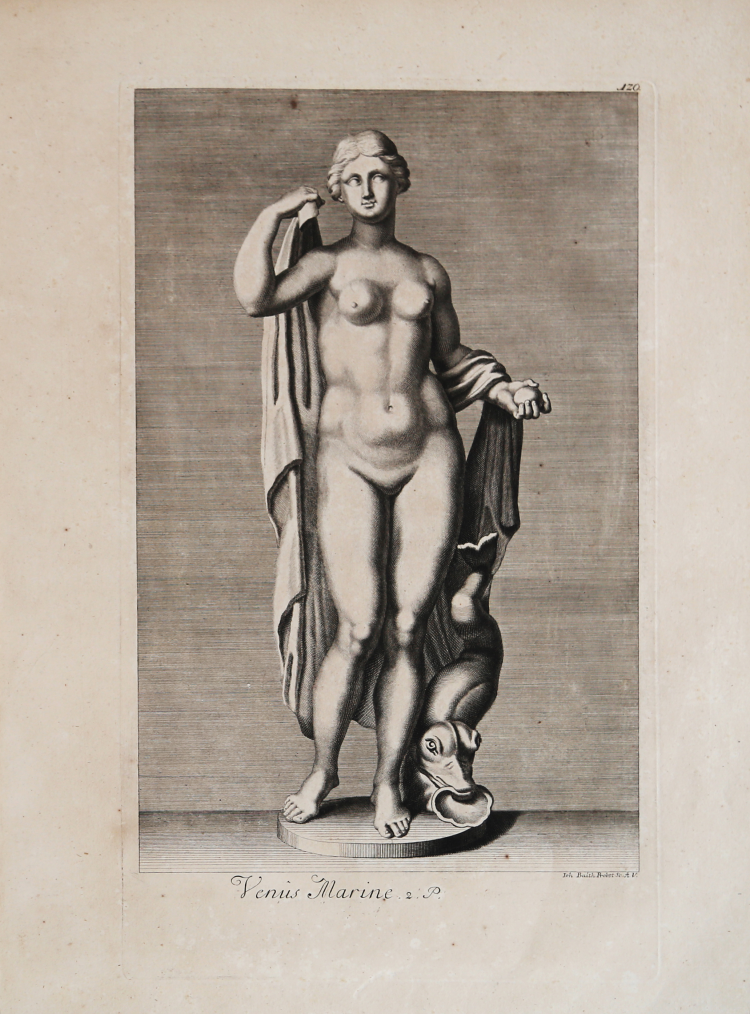



| Reference: | S36261 |
| Author | Georg Balthasar PROBST |
| Year: | 1735 |
| Printed: | Dresden |
| Measures: | 255 x 435 mm |


| Reference: | S36261 |
| Author | Georg Balthasar PROBST |
| Year: | 1735 |
| Printed: | Dresden |
| Measures: | 255 x 435 mm |
Plate from Recueil des marbres antiques qui se trouvent dans la Galerie du Roy de Pologne à Dresden […], published in Dresden by Raymond Le Plat, in 1735.
The collection of ancient and modern art at Dresden had been established by Friedrich August I (“Augustus the Strong”), who died in the same year as this book was published. He had bought antiquities from Frederick William I of Prussia (including the Bellori collection of Roman portraits) and from the Chigi and Albani families of Rome (including sculpture, vases, bronzes and mummies). Several Roman antiquities had arrived in Dresden as recently as 1729.
The plates have no accompanying explanatory texts, but most are captioned. Subjects are chiefly mythological (the collection includes copies of some famous works, such as Praxiteles's “Satyr” and Scopas's “Maenad tearing a goat”).
Almost all the plates are signed by draughtsmen and engravers. The draughtsmen were A.M. Wernerin, Joh. Justin Preissler, M. Tuscher or H. Preissler. The engravers were Lorenzo Zucchi, C.F. Boetius, Georg Mart. Preissler, Johann Balthasar Probst, Bernigeroth, Johann David Hertz, Iac. Gottlieb Thelot, Iac. Andr. Fridrich, Christian Philipp Lindemann, Hieronymus Sperling, “MB”, Joh. Jac. Steltzer or Chr. Raym. Thoman.
Etching, in very good condition.
Georg Balthasar PROBST (1732-1801)
|
Georg Balthasar Probst was a German artist, engraver and publisher in Augsburg, a major European publishing center in the 17th and 18th centuries. He produced architectural views of places around the world intended as vues d’optiques, which were published in various places during the last half of the 18th century, including Paris, Augsburg and London. He was also known for his portraits.
Probst came from an extended family of printers, whose businesses can all be traced back to the publishing firm of Jeremias Wolff (1663-1724). After Wolff's death his firm was continued as “Wolff’s Heirs” (Haeres Jer. Wolffii) by his son-in-law Johann Balthasar Probst (1689-1750). After Probst’s death in 1750, his descendants divided the business and published under their own imprints: Johann Friedrich Probst (1721-1781), Georg Balthasar Probst (1732-1801) and Johann Michael Probst.
Another part of the Wolff-Probst firm was acquired by the Augsburg publisher Johann Georg Hertel (1700-1775), whose son Georg Leopold Hertel had married a sister of the Probsts. In the next generation, Georg Mathäus Probst (d. 1788), son of Georg Balthasar Probst, also became an engraver of portraits and views.
|
Georg Balthasar PROBST (1732-1801)
|
Georg Balthasar Probst was a German artist, engraver and publisher in Augsburg, a major European publishing center in the 17th and 18th centuries. He produced architectural views of places around the world intended as vues d’optiques, which were published in various places during the last half of the 18th century, including Paris, Augsburg and London. He was also known for his portraits.
Probst came from an extended family of printers, whose businesses can all be traced back to the publishing firm of Jeremias Wolff (1663-1724). After Wolff's death his firm was continued as “Wolff’s Heirs” (Haeres Jer. Wolffii) by his son-in-law Johann Balthasar Probst (1689-1750). After Probst’s death in 1750, his descendants divided the business and published under their own imprints: Johann Friedrich Probst (1721-1781), Georg Balthasar Probst (1732-1801) and Johann Michael Probst.
Another part of the Wolff-Probst firm was acquired by the Augsburg publisher Johann Georg Hertel (1700-1775), whose son Georg Leopold Hertel had married a sister of the Probsts. In the next generation, Georg Mathäus Probst (d. 1788), son of Georg Balthasar Probst, also became an engraver of portraits and views.
|